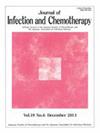目前在 HIV 护理中对肝炎合并感染的管理和认识:日本单中心回顾性研究。
IF 1.9
4区 医学
Q3 INFECTIOUS DISEASES
引用次数: 0
摘要
背景:肝脏疾病仍然是艾滋病病毒感染者(PLWH)的一个重大问题,尤其是乙型肝炎病毒(HBV)和丙型肝炎病毒(HCV)合并感染者。本研究评估了病毒性肝炎合并感染的发病率,并评价了日本艾滋病医疗服务提供者对肝炎管理的现状:这项单中心、回顾性、观察性研究分析了 2023 年 4 月 1 日至 2024 年 3 月 31 日期间接受抗逆转录病毒治疗的 PLWH 的数据。数据包括 811 名接受抗逆转录病毒疗法的 PLWH 的人口统计学特征、抗逆转录病毒疗法方案、肝炎状态和筛查方法:研究对象的中位年龄为 48 岁,97.8% 为男性。HBV 感染情况如下:慢性 HBV,6.5%;临床缓解,34.0%;未感染,30.9%;未知,14.2%。HCV 抗体阳性率为 3.2%。我们发现在肝炎筛查和监测方面存在很大差距。具体来说,我们发现在艾滋病病毒和病毒性肝炎合并感染的患者中,腹部超声波检查和 HCC 筛查的比例不足。此外,只有 71.7% 的慢性乙型肝炎病毒感染者和 61.5% 的丙型肝炎病毒感染者在过去 12 个月中接受了腹部超声波检查,而这两组患者中分别只有 5.7% 和 3.8% 的人在过去 12 个月中接受了肿瘤标志物检测:结论:在日本,HIV 和病毒性肝炎合并感染患者的肝炎和 HCC 筛查和监测工作面临挑战。这些发现突出表明,有必要提高临床实践指南的依从性,并实施综合护理模式,以加强对艾滋病毒携带者和病毒性肝炎合并感染者的肝炎管理。本文章由计算机程序翻译,如有差异,请以英文原文为准。
Current management and awareness of hepatitis coinfection in HIV care: A single-center retrospective study in Japan
Background
Liver disease remains a significant concern for people living with HIV (PLWH), especially in those with hepatitis B virus (HBV) and hepatitis C virus (HCV) coinfection. This study assessed the prevalence of viral hepatitis coinfections and evaluated the current state of hepatitis management by HIV care providers in Japan.
Methods
This single-center, retrospective, observational study analyzed data from PLWH treated with antiretroviral therapy between April 1, 2023 and March 31, 2024. Data included demographics, ART regimen, hepatitis status, and screening practices of 811 PLWH treated with antiretroviral therapy.
Results
The median age of the study population was 48 years, and 97.8 % were men. The HBV status was as follows: chronic HBV, 6.5 %; clinical remission, 34.0 %; uninfected, 30.9 %; unknown, 14.2 %. The HCV antibody positivity rate was 3.2 %. Substantial gaps in hepatitis screening and monitoring were identified. Specifically, we found inadequate rates of abdominal ultrasound examinations and HCC screening among patients with HIV and viral hepatitis coinfection. Moreover, only 71.7 % of patients chronically infected with HBV and 61.5 % with HCV underwent abdominal ultrasound examinations in the preceding 12 months—only 5.7 % and 3.8 % of the participants in these groups had had received tumor marker testing in the previous 12 months.
Conclusion
There are challenges in hepatitis and HCC screening and monitoring among patients with HIV and viral hepatitis coinfection in Japan. These findings underscore the need to improve adherence to clinical practice guidelines and implement integrated care models to enhance hepatitis management in PLWH.
求助全文
通过发布文献求助,成功后即可免费获取论文全文。
去求助
来源期刊

Journal of Infection and Chemotherapy
INFECTIOUS DISEASES-PHARMACOLOGY & PHARMACY
CiteScore
4.10
自引率
4.50%
发文量
303
审稿时长
47 days
期刊介绍:
The Journal of Infection and Chemotherapy (JIC) — official journal of the Japanese Society of Chemotherapy and The Japanese Association for Infectious Diseases — welcomes original papers, laboratory or clinical, as well as case reports, notes, committee reports, surveillance and guidelines from all parts of the world on all aspects of chemotherapy, covering the pathogenesis, diagnosis, treatment, and control of infection, including treatment with anticancer drugs. Experimental studies on animal models and pharmacokinetics, and reports on epidemiology and clinical trials are particularly welcome.
 求助内容:
求助内容: 应助结果提醒方式:
应助结果提醒方式:


